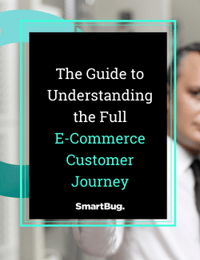
By Bill Lorimer
In the last several years, the landscape of digital technology and commerce has greatly changed. Strategies are rapidly evolving, consumers are becoming more savvy, and what worked yesterday to generate revenue no longer works today. Brands trying to stand out in today’s digital world know that it’s critical to stay ahead of the curve and catch target consumers’ eyes. You most likely already know that doing so can be the difference between being a leader in your industry and becoming just another brand that gets overlooked.
In today's digital age, you're likely to come across the term “multichannel retailing” quite often when reviewing various strategies to acquire new customers and convert them. But what does it mean? How significant is it in the e-commerce industry? And, most importantly, how can it skyrocket your brand growth? If you’re seeking those answers and looking for strategies to implement a multichannel retail strategy, read on.
What Is Multichannel Retailing?
Multichannel retailing is about making your products available on different platforms, such as your own digital storefront, online marketplaces, social media platforms, and/or brick-and-mortar locations.
Not every brand will have access to every channel/platform out there, but many businesses span across multiple platforms. If strategies across those platforms are not cohesive, the customer experience is impacted.
The importance of multichannel retailing can't be understated. With the rise of digital technology, consumers have more options than ever before. They're not confined to shopping from one source; they can pick and choose based on what’s most convenient for them at any given time. So, by offering multiple avenues for customers to make purchases, you avoid unnecessarily limiting your reach. You're essentially meeting your customers where they are, which is an effective way to grow your audience and enhance your brand's visibility. Making it easier for the consumer to purchase from your brand is critical to surviving in today’s rapidly changing economy.
Enhancing the Customer Experience & Journey
One of the key benefits of a multichannel approach is the impact it has on the customer experience and their journey. When your brand is accessible on multiple channels, your customers have the flexibility to interact with your brand in whatever way works best for them. Whether they prefer shopping online or in-store, through a mobile app or on a desktop site, they have the choice. Forcing consumers to use limited channels can easily push them away and send them running for your competition.
It's also worth noting that a key advantage of a multichannel approach is that it allows for a seamless shopping experience. Customers can browse products online to see what they like, then buy them in-store for instant gratification. Or they could discover a product on social media, then purchase it on your website.
This level of convenience isn't just appreciated by customers; it's expected. It goes without saying that not every brand has all of the retail channels at their disposal; each use case is different, and each brand must be ready to deploy a dynamic multichannel strategy based on its own unique needs. The customer experience and journey will always be the driving force behind that strategy.
Leveraging Data for Personalization
Personalization is another significant strategy and aspect of multichannel retailing. With the wealth of data available from various channels, you're able to gain a comprehensive understanding of your customers' behavior and preferences. This information can be leveraged to provide personalized experiences that resonate with your customers.
Consider this key scenario: With a solid data tracking system in place, you can follow your consumers’ browsing history and suggest products based on their behavior. Alternatively, using purchasing history, you can offer up similar products or personalized discounts for future purchases.
The possibilities for personalization are endless, and they can lead to increased customer satisfaction and loyalty. When a consumer feels like the experience is tailored to them, they’re likely to convert at a higher rate—and to direct others to your brand.
Boosting Revenue
Of course, the ultimate goal of any business strategy is to boost revenue, and multichannel retailing is no exception. By being present on multiple channels, you increase the likelihood of potential customers discovering your products. Most consumers will have a preferred channel, and giving them the ability to shop via multiple channels ensures maximum visibility. This increased visibility can lead to higher traffic, more conversions, and ultimately, increased sales.
Moreover, customers who shop across multiple channels have been shown to spend more than those who shop on just one. So, not only are you reaching more customers, but you're also increasing the average order value—which translates to higher revenue. A strong multichannel strategy is critical in your revenue strategies.
Challenges of Multichannel Retailing
Everything discussed so far has showcased how important and beneficial a multichannel retail strategy is—but the many benefits of this strategy don’t mean it is without challenges.
One challenge that will present itself early and often in a multichannel retail approach is maintaining consistency across all channels. Managing multiple channels can be a complex task. Each platform has its own set of rules, target audiences, and best practices. Your branding, messaging, and customer experience should be consistent, regardless of where your customers choose to interact with you. This consistency requires careful planning and execution. You have to be familiar with these nuances so you can effectively manage your presence on each channel and ensure the experience across those channels is cohesive.
For most brands, the most complex and biggest challenge faced will be tied to data. Managing data across multiple channels can be a daunting task. Each system is likely to generate its own set of data and handle that data differently than another system, and it's crucial that you're able to effectively collect, analyze, and utilize this data for personalization and decision-making. Incorporating a centralized location for all data can be a game changer to stay on top of this daunting task. With the recent Klaviyo customer data platform (CDP) product launch, brands that are already using Klaviyo can now incorporate data management to ease the burdens of managing their multichannel retail strategies.
Ready to Fuel Your Brand Growth Across Multiple Channels?
Multichannel retailing is a powerful strategy that can significantly boost your brand's growth and elevate you to the next level. While it does come with challenges, the benefits far outweigh them. With careful planning and strategic execution, you can leverage this approach to enhance the customer experience, boost revenue, and, ultimately, skyrocket your brand growth.

About the author
Bill Lorimer was formerly SmartBug’s AVP of E-Commerce Agency Services and he is based out of Charleston, SC. For well over a decade his focus has been growing and scaling enterprise brands within the ecommerce space at various start ups and well established agencies. His strong technical background and understanding of what makes a client tick have been key components to his success within the space. In his free time, you can normally find him cycling around Charleston or hanging out with his corgi pup. Read more articles by Bill Lorimer.










